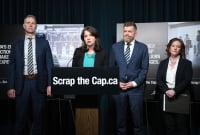Support strong Canadian climate journalism for 2025
Alongside the usual suspects at a construction site — trailers, temporary fencing and construction workers in high-visibility vests — there’s something less usual: a mature maple tucked in amongst the structure and an oak at the back.
Brightside, the non-profit housing organization that redeveloped two seniors’ housing units into a larger building in Vancouver, made it a priority to save the two stately trees. The maple was particularly challenging, said Adam James, a principal architect with Ryder Architecture who designed the building. They had to change the prescribed design to accommodate it. An arborist determined the space needed to protect the tree's roots, and during construction they built a protective boardwalk platform over top, as well as installed irrigation to ensure the trees had enough water.
“The tree told us how to design the building,” James said. However, to almost triple the number of seniors’ housing units, 15 trees — some in the middle of the site — had to be sacrificed. While they planted 29 more to replace them, it will likely take decades before the young trees provide the same benefits as a mature one.
Canada needs an additional 3.5 million housing units by 2030 to address its housing shortage. Various governments are trying to increase supply, from cities adopting “missing middle” policies, B.C. legislating municipalities to increase density, or the federal government slating public lands for affordable housing. Trees, meanwhile, help cool the air, manage stormwater, sequester carbon, decrease air pollution, provide wildlife habitat and promote people’s mental and physical health. And when they grow in the same places people are trying to build that much-needed housing, sometimes a choice has to be made: keep the trees, or cut them down?
This balance is something that municipalities across the country are grappling with as they try to address Canada’s housing and climate crises simultaneously.
'A finite amount of space'
Todd Irvine, an arborist who runs a company called City Forest in Toronto, recognizes there aren’t always easy solutions that allow for densification while keeping trees.
“Unquestionably, there’s a finite amount of space, and so every place where there’s another building is a spot there will never be a tree. And that’s just the reality,” he said.
Still, he says densification is needed, not only because of housing affordability but because it is also less damaging than the other alternative: urban sprawl. New suburbs and single family homes are the biggest contributor to urban tree loss in Canada. To build new neighbourhoods, agricultural land, forest and wetlands are cleared away.
“I would much rather lose two trees in downtown Toronto to build a building that’s going to house 100 people, then have those 100 people spread out over multiple acres in [what is] presently farmland or Greenbelt or remnant forest,” Irvine said.
He also understands that maintaining and growing an urban forest within existing neighbourhoods is needed, but that there has to be compromise.
“There needs to be sacrifices somewhere. And that sacrifice might be the big backyard, stone patio,” he said. “That sacrifice may be the two-car driveway in front of your house.”
Cars are also competing for much-needed space. A 2021 report estimated that Canada has 3.2 to 4.4 parking spaces for every car on the road — amounting to up to 97 million parking spaces.
Put together, that’s an area twice the size of Calgary that we reserve for cars, and cars alone.
“If we really wanted to provide more room for trees, one of the biggest ways to do that would be to have less cars in the city. So I would rather get rid of cars before I get rid of homes,” Irvine said.
But how those new homes are built can make a big difference to how many trees can be retained. Stephen Sheppard, a University of British Columbia professor of urban forestry, admits that it’s difficult for developers to design and construct new housing units and keep trees, but that it is “a cost of doing business.”
“If you’re a developer, it’s going to be way easier to take all the vegetation out, do whatever you need to do — grading, digging, et cetera, et cetera,” he said. “It’s much more complicated when you are trying to protect, preserve, limit the impact on the natural infrastructure.”
There are opportunities to build housing with smaller footprints. Helical piers, for example, screw into the ground and can replace a foundation that would otherwise disturb tree roots.
While protecting trees during construction might have a higher price tag, he said it will lower future costs that come from flooding, heat waves, air pollution or even the mental health impacts from living in a “concrete jungle.” Sheppard said municipalities need to enforce guardrails to protect trees and thus mitigate these costs.
The planning problem
Urban forest experts say a city should have around a 40 per cent tree canopy cover to garner its benefits. Vancouver, Toronto and Victoria are some of the country’s leafiest cities, with about 25 per cent, 28 per cent and 29 per cent tree cover, respectively, while Calgary lags far behind with just eight per cent of its sprawling area shaded by trees.
No city exceeds Ottawa-Gatineau, however, which claims a 46 per cent cover.
Tree canopy may be unequally spread between cities, but it’s also spread inequitably within cities. Low-income and racialized neighborhoods tend to have lower tree canopy — and fewer benefits — than others.
Danijela Puric-Mladenovic, a professor of urban forestry at the University of Toronto, says the distribution and lack of trees overall is the result of how Canadian cities are planned via various zoning regulations. Planners rarely look at the city’s tree cover as a whole.
“We are stuck in times when the land was abundant,” she said. “We need to grow, but we aren’t doing it in a clever way.”
Cities need to increase green space as their populations increase, Puric-Mladenovic said. While many have tree protection policies and bylaws or have developed urban forest strategies, she said that development is often the first priority.
Alex Boston, a climate consultant, says cities have an underutilized opportunity to create more green space: municipal land, which accounts for about 25 per cent of a city. Roads, back alleys and parking lots offer ample space for more trees.
“That’s the area where municipalities have the greatest degree of control. And that’s where they should start,” Boston said.
“This isn’t a zero-sum game where density necessarily drives the loss of urban tree canopy.”






Comments
I was a bit reticent about this article because too many writings about urbanism in media is window dressing. But this one hit the most salient points.
Private cars in our cities need to be dealt with. Addressing climate change while meeting the housing and food security needs of citizens starts first and foremost in cities, with particular focus on urbanizing the suburbs. That means more investment in rail transit in all its permutations, concurrent with significant land use planning effort to zone away from sprawling large lot subdivisions to whole towns. Density requires ventilation, and urban forests thrive in urban parks and generous boulevards.
I once worked on a project where three enormous suburban lots with single family houses built next to a dalmon bearing stream wer
...were converted into a 12-unit condo complex with underground parking concentrated into two of the parcels while the third was converted back to riparian forest with specialized environmental engineering (erosion control mats, native tree planting, etc.). The result was a net gain in both forest cover and housing.
Protecting existing urban trees is indeed a challenge. But new tree planting in cities today is greatly aided by underground vaults for root growth, automated drip irrigation and so forth. Building hard paved urban plazas with a generous and healthy tree canopy is possible with these techniques. Today, most arborists direct their tree planting effort into small and medium sized species concentrated in boulevards and private spaces with the large growing species placed in parks where there is more room for roots to grow without buckling sidewalks and growing into leaky older sewer lines.
By comparison, limiting the intrusion of cars with majoe transit expansion while desifying cities and building up the urban forest are far more effective elements than token green roofs and bike lanes.
Regarding food security, from an urbanist's perspective the protection of agricultural land near the urban periphery is part and parcel with reconfiguring the suburbs. A hard, permanent edge between the city and farm land is easy to maintain as long as the economic benefits of selling off farms for subdivisions is written into la
...law, as is BC's now 50-year old Agricultural Land Reserve. It helped garner political and economic acceptance to start with a shortage in food producing land to begin with, but that acceptance is very hard when you've got cities in other provinces that are surrounded by very cheap farm land so
...easily converted to sprawling car dependent subdivisions.
Along with two other authors, Cam Brewer and Sean Markey, we have recently published a book, "Nature-First Cities: Restoring Relationships with Ecosystems and with Each Other," which explains how to effectively protect and restore "urban forests," while improving equity and densification. The answers lie in the establishment of a restoration network for nature at multiple spatial scales.